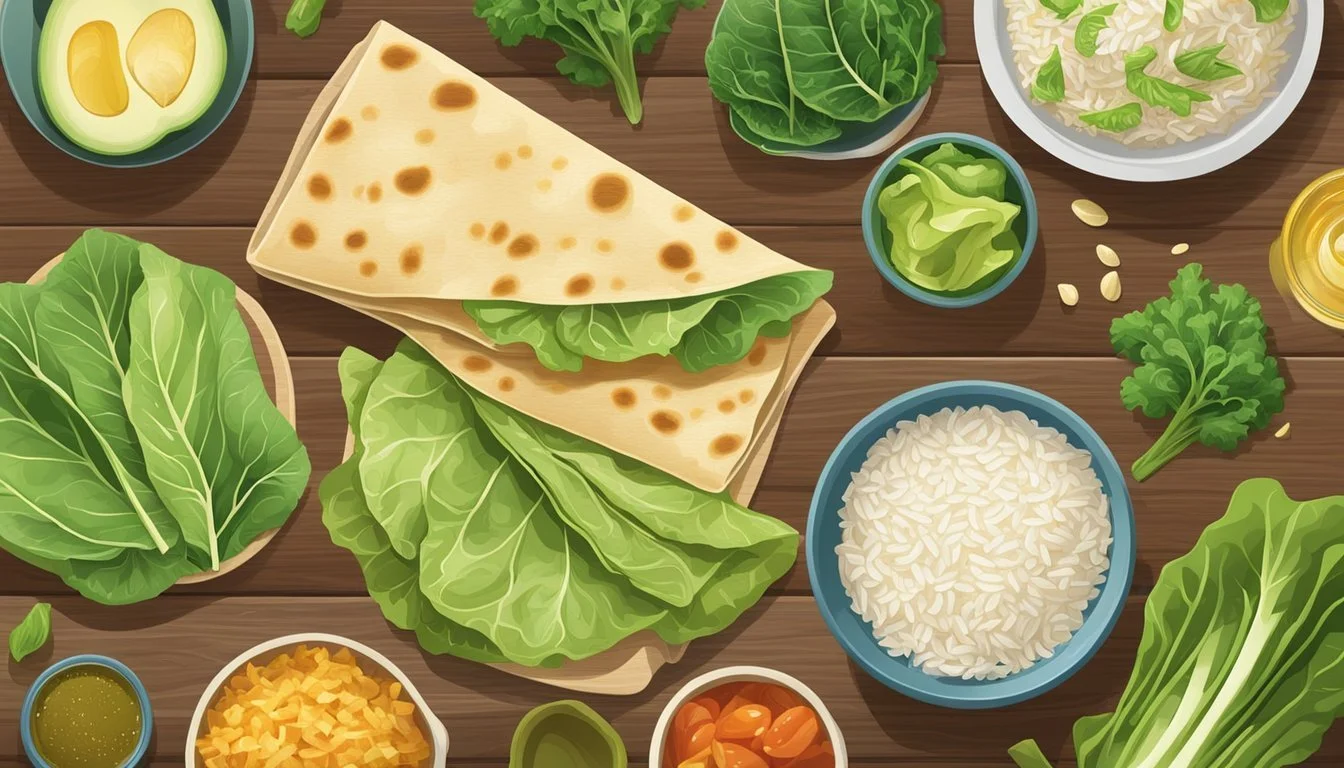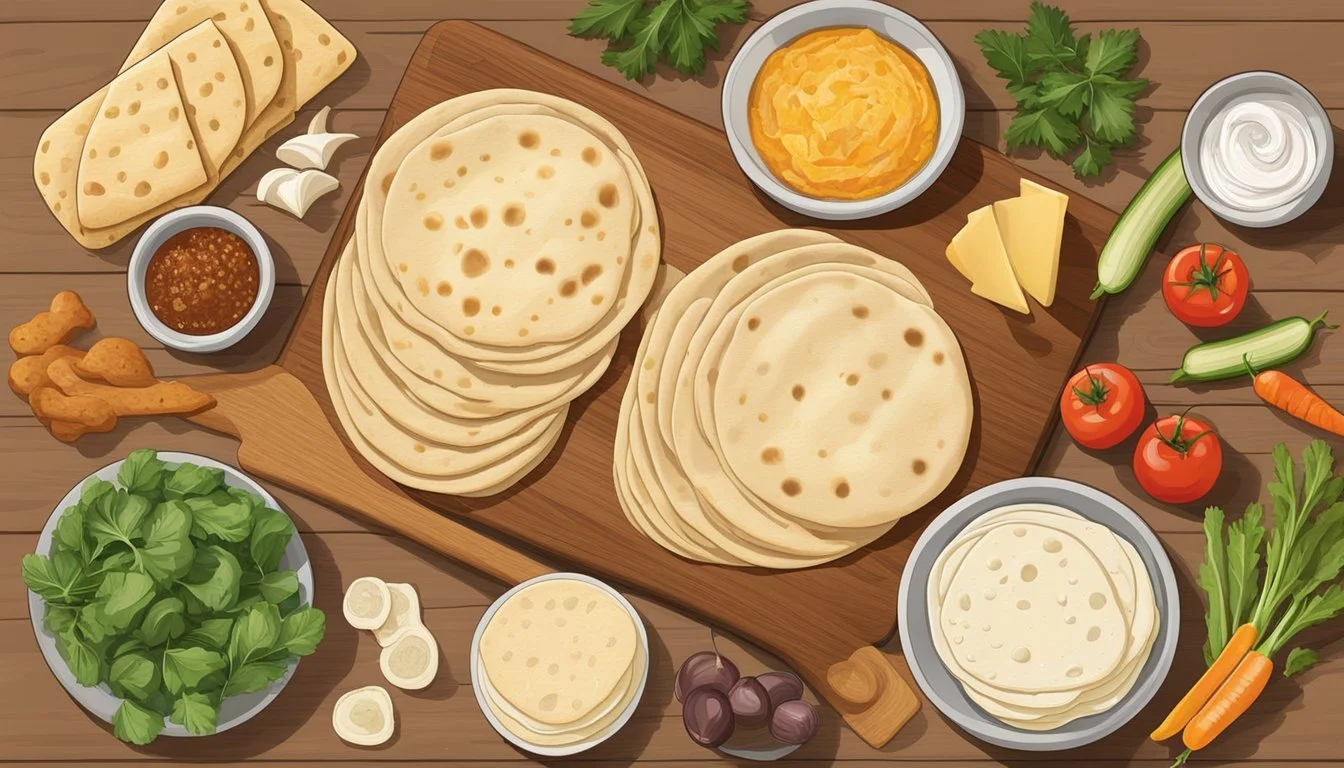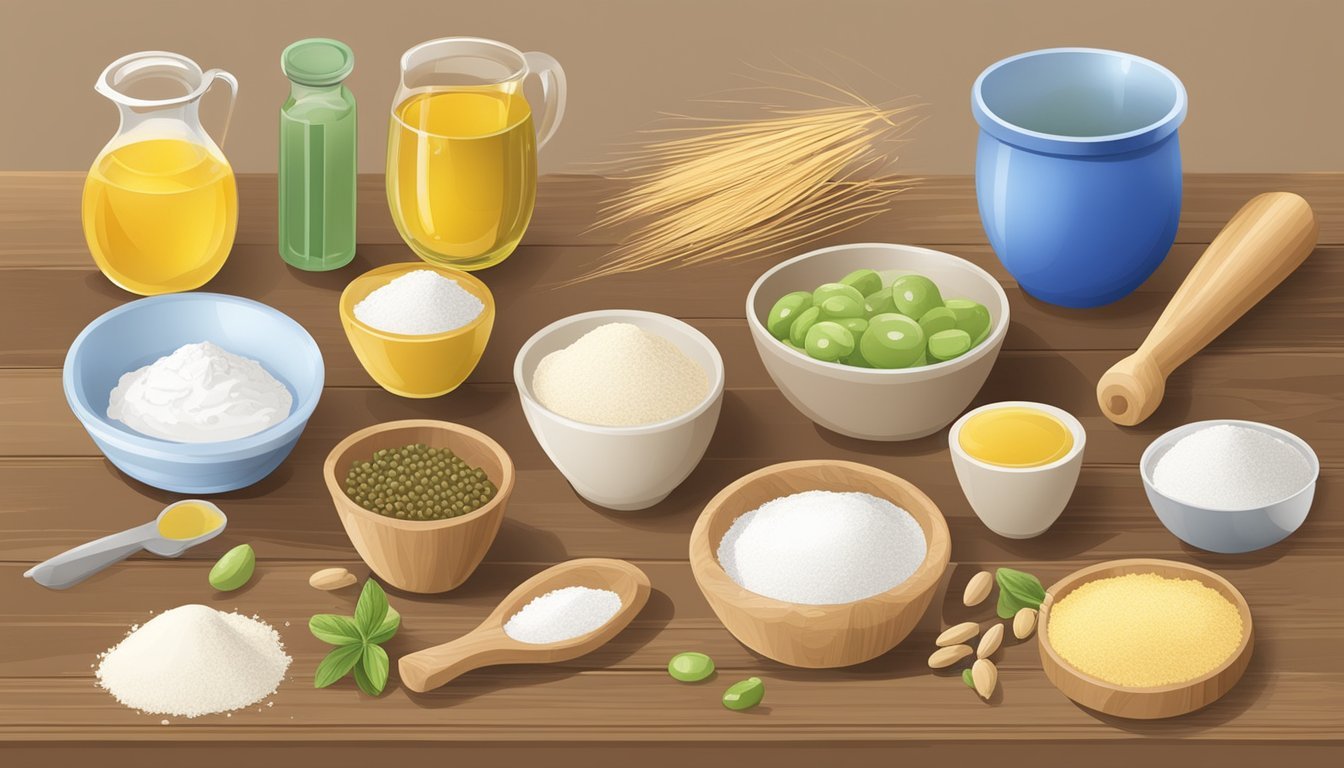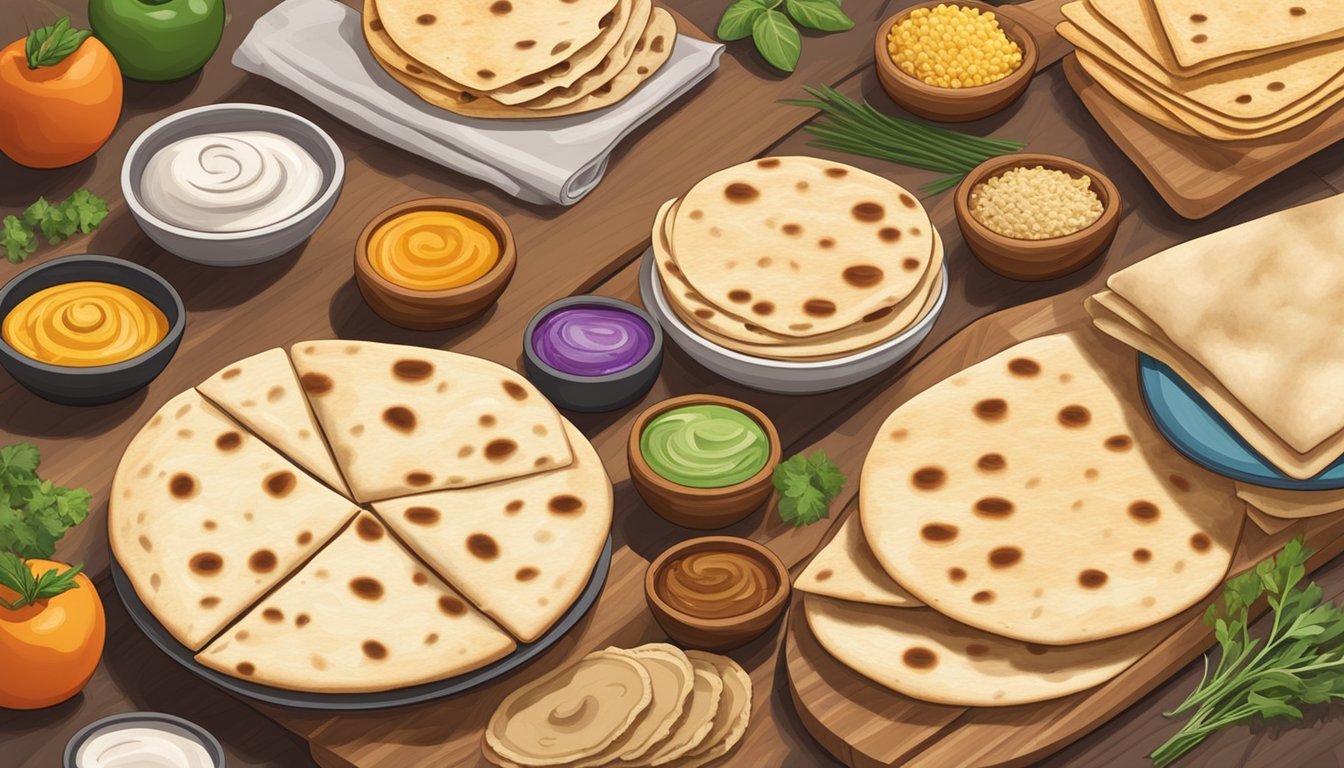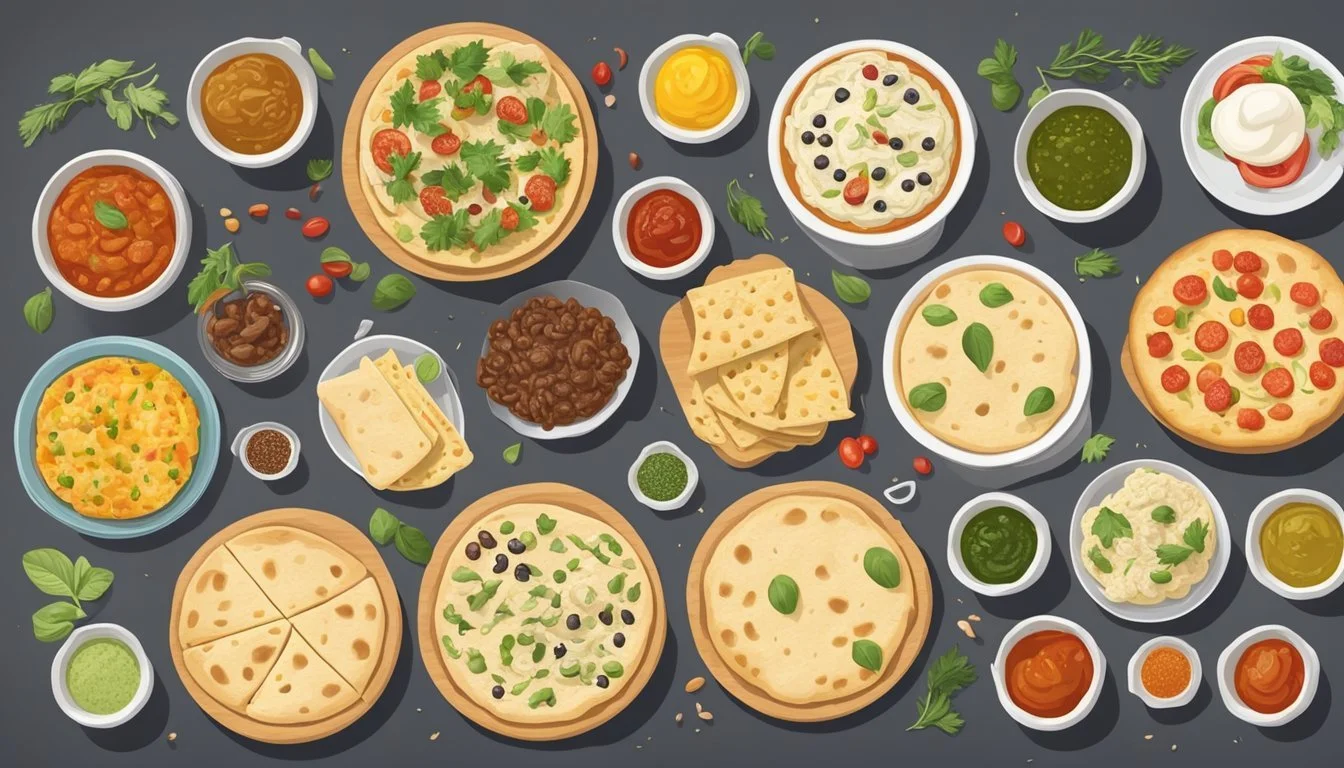Flatbread Substitutes
Top Alternatives for Your Recipes
Flatbread serves as a staple in many cultural cuisines and presents a versatile foundation for an array of dishes. However, dietary restrictions or personal health goals such as low-carb or gluten-free diets often necessitate alternatives to traditional flatbread recipes. These substitutes not only cater to specific dietary needs but also offer a diversity of textures and flavors to the discerning palate.
The quest for flatbread substitutes has given rise to innovative recipes that leverage ingredients such as almond flour or coconut flour to provide gluten-free options. These alternatives are designed to mirror the satisfying experience of traditional flatbread while ensuring that nutritional requirements are met. For those following a ketogenic lifestyle, choices such as cloud bread, made primarily from protein-rich ingredients, provide a low-carb option while still maintaining a bread-like consistency.
As consumers become more health-conscious, the demand for flatbread substitutes continues to grow. These alternatives are crafted to be not just nutritious but also easy to prepare, accommodating the fast-paced lifestyle of modern eaters. Whether used as a base for sandwiches, pizzas, or enjoyed on their own, these substitutes maintain the spirit of the original flatbread, while offering a new dimension of healthful eating.
Understanding Flatbread
Flatbreads, an integral part of global cuisines, offer a versatile and often healthier bread option, recognized for their long history and variety of types.
History and Significance
Flatbread has a storied past, tracing back to ancient civilizations. They are the oldest form of bread, and scholars often assert that flatbreads were first made thousands of years ago. Regions where they originated, such as the Middle East and South Asia, still consider flatbreads like pita bread and naan as daily staples. These breads have played a crucial role in the development of culinary practices and continue to be significant in cultural rituals and daily sustenance.
Common Types of Flatbread
Several kinds of flatbread have gained popularity worldwide:
Naan: A soft and pillowy bread made typically with wheat flour and cooked in a tandoor.
Pita Bread: Known for its pocket, it's ideal for sandwiches and is common in Middle Eastern diets.
Tortilla: A staple in Mexican cuisine, often made from wheat or corn.
Lavash Bread: A thin, soft bread popular in the Middle East that can be used rolled with various fillings.
Each type offers a unique taste and texture that complements a range of dishes.
Nutritional Profile
In terms of nutrition, flatbreads can vary greatly depending on the ingredients used. The table below outlines the basic components found in flatbread:
Nutrient Role Carbohydrates Provide energy; made up of starches and fibers. Fiber Aids in digestion; commonly found in whole wheat variations. Protein Contributes to the feeling of fullness; varies based on the type of flour used. Gluten A protein present in wheat that provides elasticity; absent in gluten-free options.
Whole wheat flatbreads are generally a good source of fiber, while those made from refined wheat offer less nutritional value. Carbohydrates are the primary macronutrient in flatbread, making them an energy-rich food. Gluten, found in wheat-based flatbreads, is important for texture but can be omitted for gluten-free diets.
Reasons for Substituting Flatbread
Substituting flatbread is often motivated by personal dietary needs or preferences and a search for healthier alternatives. The availability of ingredients and the convenience of preparation can also drive the choice of substitute.
Dietary Restrictions
People with celiac disease need to avoid gluten, which is present in many traditional flatbreads that use all-purpose or whole wheat flour. For individuals following a gluten-free lifestyle or those with gluten sensitivities, flatbread alternatives can include options made with almond flour or other gluten-free flours.
Gluten-Free Needs: Celiac disease and gluten intolerance require strict adherence to a gluten-free diet.
Keto Diet Followers: A keto diet limits carb intake, making traditional flatbread made from high-carb flours unsuitable.
Healthier Alternatives
Health-conscious consumers often seek out substitutes to reduce calorie intake and improve overall nutrition. Flatbreads made with refined flours lack the fiber found in ones made from whole wheat flour or other nutrient-dense flours like almond flour.
Lower Carb Options: Low-carb alternatives to flatbread help individuals adhere to a keto diet while still enjoying a bread-like experience.
Increased Nutrition: Using flours with better nutritional profiles, such as those high in protein and fiber, offers a healthier option than standard flatbread.
Availability and Convenience
The ease of making flatbread from scratch with available ingredients is a key consideration. For instance, no-yeast flatbread recipes are valued for their simplicity and short preparation time.
Homemade Bread: Making flatbread at home allows for customization using ingredients on hand, such as almond flour or other alternatives, to suit specific dietary needs.
Easy-to-Find Alternatives: Gluten-free and low-carb flour alternatives are more readily available, making it convenient for people to bake their own healthier option of bread while still enjoying the texture and functionality of traditional flatbread.
Substitute Ingredients for Flatbread
In the quest for alternative flatbread ingredients, one may explore gluten-free flours, non-traditional items, and vegetable-based alternatives for diverse dietary needs.
Gluten-Free Flour Options
For those avoiding gluten, various flour options can replace traditional wheat. Rice flour and corn flour cater to gluten-free requirements without compromising texture. Here are specific options:
Almond flour: Rich in flavor, it creates a tender, nutty flatbread.
Coconut flour: A high-fiber, absorbent option for a softer flatbread.
Cornbread mix: An instant solution that lends a distinct, sweet flavor commonly used in place of regular flour.
Non-Traditional Substitutes
Exploring non-traditional substitutes for flatbread can result in innovative creations. Some of these include:
Lettuce wraps: A fresh, low-calorie carrier for fillings.
Nori sheets: Seaweed used as a wrap provides a unique taste and nutrient boost.
Collard greens: Large leaves can be blanched to create sturdy and nutritious wraps.
Vegetable-Based Alternatives
Vegetables offer creative and nutritious ways to substitute traditional flatbread ingredients, especially for those seeking lower-carb options:
Cauliflower pizza crust: A blend of cauliflower rice and cheese can mimic a traditional flatbread base.
Sweet potato: Mashed sweet potato binds well and adds moisture to flatbread dough.
Cabbage: Leaves can be used as a wrap when steamed until pliable, suitable for rolling up fillings.
Homemade Flatbread Recipes
Homemade flatbread recipes offer a satisfying way to create a staple accompaniment for many meals. They provide an easy solution for everyone, whether one is looking for a quick bread option or has specific dietary requirements.
Simple and Quick Recipes
For those with time constraints or looking for convenience, no-yeast flatbread recipes are a perfect choice. They usually require minimal ingredients and no waiting time for the dough to rise. Here's a straightforward method:
Mix the base ingredients, typically flour and water, and add a bit of salt for flavoring.
Knead the dough briefly until smooth.
Rest the dough if time permits to make it easier to work with.
Roll out the dough into thin circles.
Cook in a preheated pan or skillet until each side is golden brown.
Recipes for Specific Diets
Diet-specific flatbread recipes cater to various nutritional needs, such as dairy-free or keto diets. Here's a basic outline for such recipes:
Keto Flatbread: Replace traditional flour with almond flour to fit the keto diet guidelines.
Mix almond flour with coconut oil and eggs.
Add a pinch of salt.
Roll out the dough between two pieces of parchment paper.
Cook in a skillet until fully set and slightly golden.
Dairy-Free Flatbread: Opt for non-dairy milk or water and use oil instead of butter.
Combine flour with dairy-free milk or water.
Add salt and optional seasonings.
After kneading, let it sit for a brief period.
Flatten into desired shape and cook in a non-stick pan until it puffs up.
These recipes are versatile and can be easily modified to include extra flavors or to comply with various dietary restrictions while still ensuring the end product is delicious and satisfying.
Store-Bought Flatbread Alternatives
When searching for store-bought flatbread alternatives, consumers often look for gluten-free or low-carb options to meet their dietary needs. The following subsections provide specific alternatives that cater to these dietary requirements.
Gluten-Free Bread Selections
Gluten-free flatbread alternatives are abundant in stores, catering to those with gluten sensitivities or celiac disease. One popular choice is gluten-free naan, which can be found in many grocery store chains. It offers a similar texture and taste to traditional naan but is made without wheat. Additionally, sourdough bread made from gluten-free flour blends provides an artisanal bread experience without the gluten. These products typically replace wheat with a mixture of rice flour, tapioca flour, and other gluten-free starches.
Popular Gluten-Free Brands:
Low-Carb and Keto-Friendly Options
For those adhering to a low-carb or ketogenic diet, flatbread alternatives are made with ingredients such as almond flour or coconut flour to reduce carbohydrate content. Almond flour bread is a staple in low-carb diets due to its nutrient-dense profile and lower carb count. Cloud bread is another keto-friendly substitute, made from eggs and cream cheese, offering a fluffy texture without the typical carb load of traditional flatbread.
Noteworthy Low-Carb Brands:
Julian Bakery
ThinSlim Foods
Individuals should always check the nutritional information on packaging to ensure these alternatives align with their dietary needs.
Cooking and Baking Techniques
In the realm of flatbreads, mastering specific cooking and baking techniques is crucial for achieving the desired texture and flavor, whether they are gluten-free or made with alternative cooking methods.
Working with Gluten-Free Dough
When handling gluten-free dough for flatbreads, one must be aware of its inherently fragile nature. It lacks the elasticity of gluten, which means kneading is less crucial and can be minimal or even unnecessary. Typically, binders such as xanthan gum or psyllium husk are added to help mimic the structure that gluten provides. Resting time may still be beneficial even without gluten, as it allows the flours to fully hydrate and the binders to take effect, leading to a dough that's easier to handle and results in a chewy texture. When rolling out gluten-free dough, it is advisable to do so between sheets of parchment paper to prevent sticking and tearing.
Alternative Cooking Methods
Flatbreads can be cooked using a variety of methods beyond the traditional oven baking. Here, versatility is key:
Stove-top: Cooking flatbread on the stove in a non-stick pan delivers a delightful crisp to the exterior while maintaining a soft interior. This method can be particularly useful for achieving charred and blistered textures on the bread.
Grill: Utilizing a grill can impart a smoky flavor to the flatbread that cannot be achieved in an oven or on a stove-top. It's ideal for those seeking an authentic, fire-cooked taste.
Microwave: Although not common, the microwave can be used in a pinch to cook flatbreads. This method will not provide a crispy crust but can quickly produce a soft and pliable bread.
Oven: For those looking to make larger batches or seeking an even bake, the oven is the go-to method. Homemade flatbreads can be baked at a high temperature for a short period, emulating the intense heat of a traditional flatbread oven.
By understanding these techniques and their applications, cooks and bakers can adapt to different dietary requirements and cooking environments, yielding delicious flatbreads in a variety of textures and flavors.
Serving and Pairing Ideas
When considering flatbread alternatives, it's crucial to focus on how they interact with other components in a meal. Pairings should enhance the flavor and texture of the substitute flatbread, while serving suggestions should include complementary dishes that create a balanced culinary experience.
Complementing Dishes
A flatbread substitute, such as wraps or tacos, must be paired thoughtfully with side dishes. These dishes should maintain a balance between flavors, textures, and nutritional content.
Salads: A crisp, fresh salad often pairs well with flatbread substitutes, providing a contrasting texture and lightness.
Greek Salad: Complements Mediterranean-inspired wraps.
Tabbouleh: Best served with Middle Eastern flatbread dishes like shawarma tacos.
Soups: A warm bowl of soup alongside a flatbread substitute creates a comforting and satisfying meal.
Lentil Soup: A hearty choice that goes well with spiced flatbread fillings.
Tomato Basil Soup: Ideal with a cheese-topped flatbread substitute, matching the robust flavors.
Spreads and Dips
The right spread or dip can transform a flatbread substitute into an irresistible dish.
Hummus: A versatile chickpea dip that pairs with almost any kind of flatbread substitute, adding creaminess and rich flavor.
Garlic Butter & Olive Oil: A simple combination to brush on flatbread alternatives for added moisture and taste.
Nut-based Spreads: Such as almond butter for a sweet-savory note, especially when mixed with honey.
Pair these spreads and dips with the right flatbread substitute for an enhanced eating experience:
Flatbread Substitute Recommended Spread/Dip Wraps Hummus, curry spreads Sandwiches Olive oil, garlic spread Tacos Spicy dips, guacamole
Preserving Flatbread Substitutes
Preserving flatbread substitutes properly is crucial for maintaining their freshness and extending shelf life. Proper storage techniques and preparing these substitutes in advance can ensure they remain as close to their intended texture and flavor when used later.
Storage Techniques
Room Temperature: Flatbread substitutes, such as tortillas and pita bread, can be kept at room temperature for a short period. They should be stored in a cool, dry place inside a sealed container or wrapped in plastic wrap to prevent them from drying out. Typically, this method will preserve them for up to a week.
Refrigeration: For longer storage, one can refrigerate flatbread substitutes. Place them in a zip-top bag or an airtight container with a piece of parchment paper between each piece to prevent sticking. This method extends their freshness for up to two weeks.
Freezing: Flatbread substitutes freeze well for long-term storage. Wrap individual pieces in cling film and then place them in a freezer bag. It's important to squeeze out as much air as possible before sealing to prevent freezer burn. Substitutes can be frozen for up to three months. To use, thaw at room temperature or reheat directly from frozen, depending on the product.
Making Substitutes in Advance
Preparing flatbread substitutes in advance is a matter of practicality and convenience, especially for batch cooking.
Preparation: When preparing a batch of flatbread substitutes, it’s beneficial to cook them to just under their usual cooking point if they are intended to be reheated later. This prevents them from becoming overcooked or tough when they are finished off or reheated.
Storing for Advance Use: After cooking, let the flatbread substitutes cool completely. Then, follow the same refrigeration or freezing guidelines provided above. Labeling the storage bags with the date of preparation ensures that one uses the oldest batch first, a practice known as "first in, first out" that supports effective rotation and usage.

